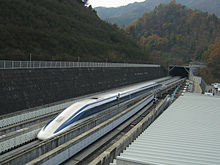Electrodynamic lift
Electro-dynamic buoyancy ( English suspension electrodynamic EDS) is an expression of the magnetic levitation in which a repulsive force from the interaction of induced currents with a magnetic alternating field arises.
The alternating magnetic field which causes the induced currents can, for. B. by a relative movement of a permanent magnet over an electrically conductive plate, for example an aluminum plate, or by applying AC voltage to a coil system , e.g. B. a linear stator are generated.
Types
Moving permanent magnets
The simplest case of electrodynamic storage is when a permanent magnet moves over a conductive metal plate. Eddy currents are generated in the plate , and these in turn generate a repulsive Lorentz force with the magnetic field of the permanent magnet. In addition, there is a braking force against the direction of movement of the magnets. Such an arrangement with permanent magnets is used in the experimental magnetic levitation system Inductrack . In a Halbach array , it could also be used for future high-speed traffic such as the Hyperloop .
Linear asynchronous machine
A linear asynchronous machine consists of a linear stator and a secondary side in which currents are induced. In the simplest case, the secondary side only consists of a conductive plate. The moving magnetic field of the linear stator creates eddy currents in the plate and this results in a thrust and buoyancy force. This arrangement can thus be used for electrodynamic levitation and propulsion.
Electrodynamic bearing
The electro-dynamic bearings ( electrodynamic bearings , EDB) are mechanical bearings, which can not only generate a lift force, but a restoring force. This also z. B. radial bearings can be realized. Electrodynamic bearings are typically dynamically stable by themselves and control is not required.
Individual evidence
- ↑ M. Flankl, T. Wellerdieck, A. Tüysüz and JW Kolar: Scaling laws for electrodynamic suspension in high-speed transportation . In: IET Electric Power Applications . November 2017. doi : 10.1049 / iet-epa.2017.0480 .
- ↑ I. Boldea: Linear Electric Machines, Drives, and MAGLEVs Handbook . CRC Press, Boca Raton 2013, ISBN 978-1-138-07633-4 .



